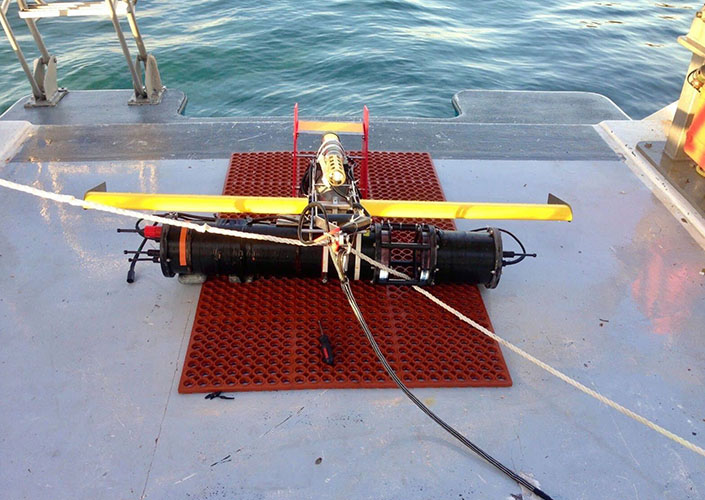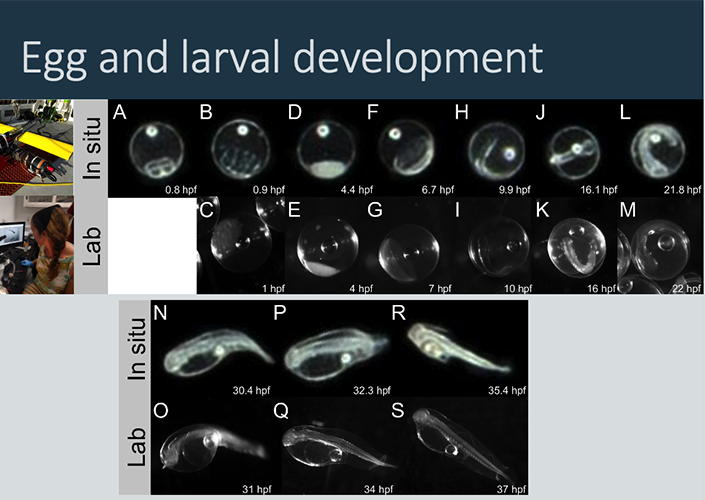Researchers Track Endangered Nassau Grouper Eggs with Underwater Microscope
Scripps Oceanography researchers show fertilized eggs stayed local, but in some years drifted to nearby islands.
Each winter off the western tip of the Caribbean island of Little Cayman, thousands of endangered Nassau grouper gather to spawn under the light of the full moon. The fish pack the coral reef and when the ritual begins individual females dash out of the fray straight up towards the surface with multiple males in pursuit. During these vertical bursts, females release their eggs and the males jostle to fertilize them, leaving milky plumes drifting in the moonlit sea.
These precious fertilized eggs are the engine that powers the still-limited recovery of this critically endangered species that is a key reef predator and was once the target of an important fishery in the Caribbean. But where do these eggs end up after they’re cast adrift?
Scientists at the University of California San Diego’s Scripps Institution of Oceanography, Oregon State University (OSU), and the conservation organization Reef Environmental Education Foundation (REEF) teamed up with the Cayman Islands Department of the Environment to address this question by physically tracking clouds of tiny, transparent Nassau grouper eggs through the night with an underwater microscope developed by Scripps Oceanography Marine Physical Laboratory scientist Jules Jaffe.
In a new study, published May 9 in the Proceedings of the Royal Society B, the researchers show that fertilized eggs from the Little Cayman spawning site floated back onto reefs elsewhere on the island in 2017. Drawing on these direct observations and ocean current data collected on spawning nights at Little Cayman, the team also used a computer model to investigate where the fertilized eggs likely went in 2011 and 2016.
The model predicted that many of the baby Nassau grouper ended up back at Little Cayman in 2011, a suggestion that dovetails with prior research showing that the 2011 reproductive season led to a significant population increase around Little Cayman. For 2016, the model predicted that currents carried some fertilized eggs to the nearby island of Grand Cayman – a population of Nassau grouper that has not recovered as well as the one on Little Cayman.
The study, funded by the Cooperative Institute for Marine Ecosystems and Climate, National Science Foundation, UC San Diego, UC Office of the President, and the UC-HBCU Oceans as a Bridge Program, demonstrates how reproductive success and the final destination of the grouper eggs can vary from year to year, while also showing that local conservation measures to protect Nassau grouper are boosting local populations and sometimes providing spillover benefits to neighboring islands.
“This study helps us understand one of the key physical processes behind any population growth or conservation success we end up seeing for this important, endangered reef fish,” said Brian Stock, the study’s first author who conducted the research as part of his PhD at Scripps and who is now a scientist with Norway’s Institute of Marine Research.
“Getting this done was a huge technical challenge that really benefited from bringing together the wide ranging expertise of Scripps scientists.”
-Brian Stock
 Brian Stock prepares to deploy drifters, which track ocean currents, into plumes of fertilized eggs from spawning Nassau grouper off Little Cayman, Cayman Islands. Image credit: Andy Mullen (Scripps)
Brian Stock prepares to deploy drifters, which track ocean currents, into plumes of fertilized eggs from spawning Nassau grouper off Little Cayman, Cayman Islands. Image credit: Andy Mullen (Scripps)
There were once millions of Nassau grouper in the Caribbean, but their spectacular full moon aggregations made them easy targets for fishers. By the 1980s most populations had steeply declined and many spawning aggregations no longer formed. The Cayman Islands government enacted temporary protections that halted fishing in 2003, and established permanent protections in 2016 that included no fishing during the spawning season (December to April) as well as year round size and number limits.
On Little Cayman, protection allowed the Nassau grouper population to recover from around 2,000 fish to roughly 7,000 by 2018. In that same time period, the population around nearby Cayman Brac grew from about 500 to 2,000. Grand Cayman’s population has yet to show signs of recovery, but conservation measures provide an essential foundation for a big reproductive year to restart the population.
One of the key research findings from the Grouper Moon Project, a conservation science partnership between REEF, the Cayman Islands Department of the Environment, and researchers from Scripps and OSU started in 2002, is that Nassau grouper don’t island hop as adults. This means that populations will only rebound through local reproduction or through lucky years when the currents ferry in larvae from larger populations on other islands.
Stock said this is one of the key reasons he and his colleagues wanted to track the fertilized eggs from Little Cayman, which hosts the largest known aggregation of Nassau grouper in the world. They wanted to know if Little Cayman grouper were replenishing their own numbers, and if this healthy population could potentially seed recovery on other islands.
To find out, the team combined multiple lines of data and executed a tightly choreographed marathon of field work.
On February 14, 2017 the grouper gathered at sunset while a contingent of research divers waited for the show to start. Once the fish started spawning the divers signaled to other members of the team on a nearby boat to release a drifter – a huge canvas sock that gets pulled along with the current at a depth of around 50 feet tethered to a flashing spherical buoy on the surface. The divers released five drifters into the middle of the egg plume over the course of the spawn.
As the drifters moved away from the aggregating fish, the boat followed their flashing lights for 15 hours straight while towing a specially designed underwater microscope back and forth across the drifters’ path.
Jaffe’s team originally designed the device to document local marine life by taking photographs of tiny, mostly transparent plankton while affixed to Scripps Pier. This made it the perfect choice for Stock and his co-authors to adapt so they could observe how the similarly tiny, transparent grouper eggs dispersed after being fertilized. By towing the microscope in a zig-zag pattern across the area defined by the flashing drifters, the researchers could see whether the eggs were moving with the current, or if they were spreading out into the wider ocean.
Nassau grouper typically spawn for multiple nights in a row, so the team went back and repeated the same process the very next night, this time shadowing the floating patch of eggs for 36 hours. Over the two spawning nights in 2017, the researchers captured 238,184 images, and subsequently identified 2,265 as Nassau grouper eggs. Importantly, each of these photos were paired with 3D location data so they could be plotted in space and time.
 The underwater microscope that researchers towed behind their boat to capture photos of plankton and Nassau grouper eggs for the study. Its wings allowed it to control its depth. Image credit: Andy Mullen (Scripps)
The underwater microscope that researchers towed behind their boat to capture photos of plankton and Nassau grouper eggs for the study. Its wings allowed it to control its depth. Image credit: Andy Mullen (Scripps)
 Image sequences of Nassau grouper egg and larval development over 1–37 hours post-fertilization (hpf). Top: in situ Scripps Plankton Camera images taken in the egg cloud spawned on 15 February 2017. Bottom: light microscope images of eggs and larvae collected from the same spawning event by divers and raised in the lab. Photographers: Brian Stock (Scripps), Andy Mullen (Scripps), Alli Candelmo (Reef Environmental Education Foundation), Grouper Moon Project
Image sequences of Nassau grouper egg and larval development over 1–37 hours post-fertilization (hpf). Top: in situ Scripps Plankton Camera images taken in the egg cloud spawned on 15 February 2017. Bottom: light microscope images of eggs and larvae collected from the same spawning event by divers and raised in the lab. Photographers: Brian Stock (Scripps), Andy Mullen (Scripps), Alli Candelmo (Reef Environmental Education Foundation), Grouper Moon Project
After analyzing this mountain of data, the team found that on the first night of spawning the eggs went north, with one drifter ending up near the southern coast of Cuba 18 days later. But on the second night in 2017, the eggs and larvae spawned at the Little Cayman aggregation were mostly delivered back to Little Cayman reefs.
Stock and his colleagues also had drifter data from the 2011 and 2016 Nassau grouper spawns on Little Cayman, and by combining them with their direct observations in 2017 they were able to create a model to predict where the fertilized eggs likely ended up in 2011 and 2016.
The models predicted that the 2011 Little Cayman spawn, a key reproductive year that subsequently drove population recovery around the island, mostly sent eggs back to Little Cayman reefs. For the 2016 spawn, the model suggested that fertilized eggs ended up at Grand Cayman, a neighboring island with a depleted Nassau grouper population.
Stock said the study’s results confirm that the cloud of eggs generally stays close enough together to make drifters a reliable and relatively low-tech way to evaluate where larvae are likely to end up in the first 24 hours after spawning. The findings also show that the thriving Little Cayman population of Nassau groupers appears to be self-replenishing as well as occasionally donating larvae to nearby islands.
“At least on Little Cayman, local protections benefit local fish populations, which can be a really useful incentive to motivate conservation,” said Stock. “It also highlights the importance of protecting fish spawning aggregations for other species that reproduce that way. There are lots of fish species that form aggregations like Nassau grouper, so these lessons could be useful for conserving other species.”
Finding a way to physically track the fertilized eggs also paves the way for one day understanding what accounts for reproductive booms like the one the Little Cayman Nassau grouper experienced in 2011.
“People have been trying to do that for 100 years, but this moves us closer to being able to one day, in a particular place tease apart the drivers – whether it’s transport, predation, or starvation – behind these years where large numbers of larvae survive,” said Stock. “That’s fundamental to whether a population increases, and the better we can understand it the more effectively we can do conservation and manage fisheries.”
Other researchers
In addition to Stock and Jaffe, Andrew Mullen and Brice Semmens of Scripps Oceanography, Allison Candelmo of REEF and the Central Caribbean Marine Institute, Scott Heppell of OSU, Christy Pattengill-Semmens of REEF, Croy McCoy of the Cayman Islands Government DOE and Bangor University, and Bradley Johnson DOE Cayman Islands Government are co-authors.
Publication: Brian C. Stock, et al, Protected fish spawning aggregations as self-replenishing reservoirs for regional recovery, The Royal Society Publishing (2023) DOI: 10.1098/rspb.2023.0551
Original Story Source: UC San Diego

 Alerts Sign-up
Alerts Sign-up